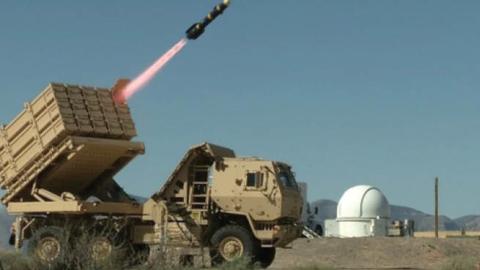The dominance in coordination, intelligence, and targeting that enabled American victory in conventional conflicts throughout the post-Cold War period is eroding. China in particular has invested in C4ISR networks to coordinate its dispersed missile-armed forces, a critical capability if the Beijing regime hopes to strike Taiwan or another regional target while simultaneously forestalling American intervention.
A war with China – the most likely and most significant great-power contingency that the U.S. and its allies will face – will involve tens of thousands of discrete moving units. China will attempt to saturate targets in the Western Pacific with missile salvos, launched from surface warships, aircraft, and ground installations. The U.S. must be able to coordinate American and allied units effectively enough to defend critical targets from air attack, and in turn strike back at enemy forces throughout the region.
American and allied forces must fight as a team, maximizing limited resources by allocating specific responses to specific threats. This goes beyond the “jointness” that dominates conventional Western military planning. As it stands, the majority of Western European states, all the U.S. armed forces, and several Asian allies use the standardized Link 16 system, a tactical data link network that enables communication and information-sharing between different units and across services. But the individual ships, air defense platforms, radar stations, and aircraft often have different software for intelligence, surveillance, reconnaissance, and targeting. Broadly speaking, all the American services and major allied forces are interoperable. Nevertheless, internal software differences can generate critical discrepancies between the data individual units send to their commanders.
These discrepancies are particularly important in aerial combat. China’s saturation strikes will flood American and allied radars with thousands of distinct targets, ranging from standard cruise and ballistic missiles and strike aircraft to unmanned aerial vehicles, strategic bombers, and hypersonic weapons. Even simple discrepancies between targeting data in the “air picture” – the military term for the visual representation a commander receives of local and regional air combat – can prove disastrous. Indeed, the Missile Defense Agency has already identified this problem during its wargames, when it has attempted to integrate air data from the THAAD anti-ballistic missile system and Aegis Naval Combat System, and from THAAD and the Patriot surface-to-air missile system.
Every service understands the need for effective information coordination. To that end, each has developed its own system to integrate data. But sensor data integration occurs only after each service’s specific tools have collected and collated it, and then sent it through the Link 16 or the similar Link 11 – or future Link 22 – network. These inefficiencies stem from the Defense Department’s structural constraints. Individual programs are “stovepiped,” and therefore developed independently of their technologically equivalent counterparts with little thought to organic integration.
The Army’s Integrated Battle Command System strips away these additional layers of transmission and processing, fusing all the data from the systems in which it is installed into a single data picture. IBCS accomplishes this by replacing each combat system’s command-and-control software with the IBCS’ command modules. Each IBCS-equipped unit is connected to every other; the system is designed to run in the background during any deployment, continuously fusing data and generating an air picture that it then distributes throughout the combat force.
But sensor fusion and a unified understanding of the battlespace is not enough, especially when thousands of targets and threats flood radar screens. To that end, IBCS includes a threat assessment program, which combines fused targeting data with information on friendly capabilities and positions to generate targeting options that maximize U.S. forces.
IBCS and similar systems are currently defensive. However, testing has begun that translates these capabilities into offensive missions. During an August 2019 test, IBCS used additional sensor data from short-range radars and F-35 tracking tools to conduct an intercept far outside the Patriot’s organic radar range. This has obvious offensive applications. Units equipped with UAVs and short-range sensors can transmit data back to allied forces out of harm’s way, which in turn can conduct strikes against targets beyond standard detection ranges. Indeed, as the U.S. Marine Corps shifts to a maritime island-hopping force, information integration technology like IBCS will become increasingly important: Marines forward-deployed on isolated islands can have an outsized effect on the broader battlespace, directing fire for long-range missiles much like the spotter aircraft of bygone battleships.
As important as IBCS will be the Navy’s equivalent program, the Cooperative Engagement Capability, or CEC, integrated fire control sensor network. It is reasonable for both services to develop separate C4ISR integration programs, particularly because multiple systems enable greater redundancies. Nevertheless, each service must attempt to integrate its battle management systems with those of every other. IBCS is already integrated with the F-35, but full-scale inter-service integration is critical to future combat effectiveness. Earlier integration attempts will improve combat effectiveness once IBCS, CEC, and other similar systems are fully mature. By waiting too long, the U.S. risks encountering the same stovepiping issues that necessitated sensor fusion programs in the first place.
Absent a massive spending cut, the Army is likely to deploy IBCS in the next few years, beginning with low-rate initial production and expanding over time. However, simply developing IBCS or a similar data fusion system is insufficient. Unless the Army, or any other service with similar software, integrates IBCS into all critical air defense systems, IBCS will not have a major effect. As it stands, the Army does not plan to integrate IBCS into its THAAD or Ground-Based Midcourse Defense systems, two major pillars of Army air defense, because of funding gaps in the 2022-26 budgets. These issues are compounded when considering interservice integration. Navy budget shortfalls could jeopardize both CEC and naval systems integration with IBCS. Congressional leadership is needed, not only to ensure steady funding, but also to guide the services as they invest in data fusion technologies and link them into a broader command and control network.
China is, and will likely remain, the most powerful challenger to the U.S. position in the world and to the international order. It continues to transform itself from a land to a land/sea power broadening the areas of strategic competition to include purchases of strategic port facilities and other critical infrastructure, control of 5G networks, debt diplomacy and cyber-attacks. None of this can be allowed to obscure the fact that battlefield dominance remains the spine of any state’s ability to prevail. As battlefield dominance becomes vastly more intricate and as our potential foe’s systems multiply in number and complexity, the assured integration of U.S. forces is an unqualified necessity.
Read in Defense One

















